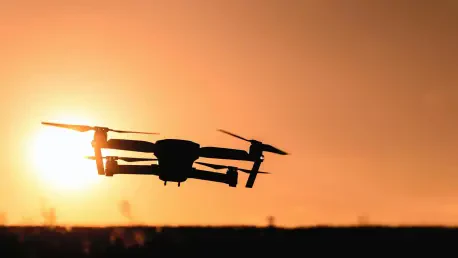In the vast and varied landscapes of Kenya, where remote communities often struggle to access even the most basic medical supplies, a revolutionary solution is taking flight—literally. Drone technology has emerged as a game-changer in addressing the persistent challenges of healthcare delivery, particularly in underserved regions. With rugged terrains and limited infrastructure posing significant barriers, the timely distribution of life-saving resources like blood, vaccines, and essential medicines remains a critical issue. At a recent high-profile event focused on devolution and health equity, industry leaders and policymakers gathered to discuss how innovative partnerships and cutting-edge tools can bridge these gaps. Drone delivery systems, spearheaded by companies like Zipline, are proving to be more than just a futuristic concept; they are becoming a lifeline for thousands. This discussion sets the stage for exploring how such technology can redefine access to healthcare across the nation.
Revolutionizing Last-Mile Delivery with Drone Technology
The concept of last-mile delivery has long been a stumbling block in Kenya’s healthcare system, especially for rural and hard-to-reach areas where roads are often impassable or nonexistent. Drone technology offers a transformative approach by bypassing these physical barriers entirely. Capable of delivering medical supplies directly to clinics and hospitals in a matter of minutes, drones ensure that critical items like blood for transfusions or vaccines for disease prevention arrive when they are needed most. A notable example is the impact seen in counties such as Homa Bay and Kisumu, where drone services have drastically reduced delays in emergency situations. This speed not only saves lives but also builds trust in health systems among communities that have historically been left behind. By integrating such technology into the supply chain, the potential to create a seamless flow of resources becomes a tangible reality, addressing one of the most pressing logistical challenges in healthcare delivery.
Beyond speed, the reliability of drone systems adds another layer of value to their implementation in healthcare logistics. Unlike traditional transport methods that can be disrupted by weather, traffic, or infrastructure failures, drones operate with a level of consistency that is vital for maintaining cold chain integrity for items like vaccines. Data from operations in regions like Kericho and Nyamira shows that over 213,000 vaccine doses have been successfully distributed using this method, ensuring that temperature-sensitive supplies remain effective upon arrival. Additionally, the ability to provide on-demand deliveries means that health facilities no longer need to overstock supplies, reducing waste and costs. This efficiency is particularly crucial for managing outbreaks or sudden spikes in demand during public health emergencies. As drone technology continues to evolve, its role in creating a resilient and adaptable supply chain framework is becoming increasingly clear, offering a blueprint for scalability across the country.
Building Equitable Healthcare through Public-Private Partnerships
Achieving equitable healthcare access in Kenya requires more than just technological innovation; it demands a coordinated effort between government bodies and private sector players. Drone delivery initiatives, such as those led by Zipline, exemplify how partnerships can drive systemic change. By collaborating with county governments in areas like the Lake Region Economic Bloc, these programs have already delivered nearly 1,000 units of blood, cutting transfusion referrals by a significant margin. Such collaborations ensure that the technology aligns with local health priorities, addressing specific needs like emergency response and chronic disease management. The shared vision among stakeholders is to make healthcare a right, not a privilege, for every Kenyan, regardless of their geographic location. This alignment of goals fosters an environment where innovation can thrive while remaining grounded in the realities of public health challenges.
Another critical aspect of these partnerships is their ability to scale impact through data-driven insights and community engagement. For instance, drone programs have reached over 8,700 high-risk youth with prevention medication, achieving retention rates that far surpass traditional facility-based care. This success is attributed to the agility of drone systems, which can adapt to urgent needs and deliver directly to where patients are, rather than requiring them to travel long distances. Moreover, the involvement of international humanitarian organizations in supporting these initiatives highlights the global recognition of Kenya’s potential to lead in this space. By fostering dialogue between county officials, tech innovators, and health experts, these partnerships lay the groundwork for a national supply chain framework. The emphasis on integration ensures that drone technology does not operate in isolation but becomes a core component of a broader strategy to advance Universal Health Coverage across diverse populations.
Paving the Way for a Healthier Future
Reflecting on the strides made in Kenya’s healthcare landscape, it’s evident that drone technology has carved a path toward equity where traditional methods fell short. The remarkable delivery of hundreds of thousands of vaccine doses and essential medicines to remote corners of the nation stands as a testament to what innovation can achieve when paired with determination. Collaborative efforts between local governments and private entities like Zipline have reshaped emergency response, ensuring that life-saving supplies reach those in dire need without delay. Looking ahead, the focus must shift to scaling these successes through a unified national strategy that prioritizes investment in infrastructure and training. Expanding drone networks to cover more regions, coupled with policies that streamline regulatory processes, will be crucial next steps. By continuing to harness technology and foster partnerships, Kenya can solidify its position as a global leader in healthcare innovation, turning the vision of accessible care into a lasting reality for all its citizens.









